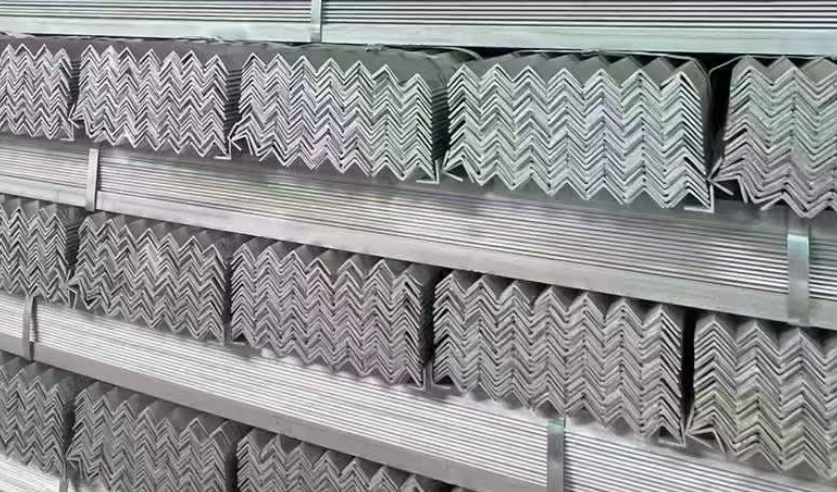In construction and manufacturing, stainless steel angle and galvanized steel angle are both very important metal materials, but there are significant differences between them. So, stainless steel angle vs galvanized steel angle – what’s the difference? This article will explain the differences between them from the following aspects.

Stainless Steel Angle vs Galvanized Steel Angle – What’s the Difference?
Stainless Steel Angle vs Galvanized Steel Angle – 1. Material Properties:
Stainless steel angle refers to steel that resists weak corrosive media such as air, steam, water, and chemical corrosive media such as acids, alkalis, and salts. It is also known as stainless acid-resistant steel. Stainless steel angle is a steel product that adds other metal elements to the interior of the steel, resulting in structural changes within the product that prevent it from rusting. Stainless steel angle has good mechanical properties and corrosion resistance, and is widely used in construction, decoration, food, medical, and other fields.
Galvanized steel angle refers to coating a layer of metal zinc on the surface of the ordinary steel angle, aiming to prevent the surface of steel plate from corrosion and extend its service life. The galvanized steel angle is divided into hot-dip galvanized steel angle and cold-dip galvanized steel angle. Hot-dip galvanized steel angle is to immerse the rusted steel angle into the molten zinc liquid at about 500℃, so that the surface of the steel angle is attached with a zinc layer, thus achieving the purpose of corrosion prevention.
Cold-dip galvanized steel angle uses electrochemical principle to ensure full contact between zinc powder and steel, resulting in electrode potential difference for corrosion prevention. Galvanized steel angle has the advantages of low processing cost, durability, good reliability, strong coating toughness, comprehensive protection, etc. It is mainly used in power towers, communication towers, curtain wall materials, shelf construction, railway, highway protection, and other fields.
Stainless Steel Angle vs Galvanized Steel Angle – 2. Applications:
The uses of stainless steel and galvanized steel angles mainly depend on their material properties and corrosion resistance. Generally speaking, stainless steel angles are more suitable for applications with high hygiene requirements or harsh environments, such as food processing, catering, brewing, and chemical industries. Stainless steel angles can also be used in the construction sector as one of the strongest materials in metal construction, and also have good decorative effects.
Galvanized steel is more suitable for general industrial and civil buildings as structural or supporting members. Galvanized steel can effectively prevent ordinary steel from oxidizing and rusting in the air, extending its service life and reducing maintenance costs. Galvanized steel can also be used in some special applications, such as power towers and communication towers, as they need to withstand high wind pressure and electromagnetic interference.
Stainless Steel Angle vs Galvanized Steel Angle – 3. Application Scenarios:
The application scenarios of stainless steel and galvanized steel angles are mainly related to their uses. The following are some common scenarios for example:
- Stainless steel angles can be used in the production of kitchen utensils, tableware, sinks, faucets, etc., as they need to frequently contact water and food, requiring good hygiene and corrosion resistance.
Stainless steel angles can also be used in the production of medical devices, surgical instruments, dental instruments, etc., as they need to meet strict sterilization and disinfection requirements, requiring high antibacterial and heat resistance. - Stainless steel angles can also be used in the production of elevator decorative panels, staircase handrails, window frames, etc., as they require excellent mechanical properties and aesthetically pleasing appearance, requiring high gloss and scratch resistance.
- Galvanized steel angles can be used in the production of warehouse shelves, supermarket shelves, display stands, etc., as they need to bear large loads and frequent placement, requiring high strength and wear resistance.
- Galvanized steel angles can also be used in the production of street lamp poles, traffic signs, billboards, etc., as they need to be exposed to the outdoors for a long time, requiring good corrosion resistance and weather resistance.
- Galvanized steel angles can also be used in the production of power towers, communication towers, wind power towers, etc., as they need to operate at high altitudes or remote locations away from people, requiring high safety and reliability.
Stainless Steel Angle vs Galvanized Steel Angle – 4. Case Studies:
The cases of stainless steel angle and galvanized steel angle mainly reflect their application effects in different fields. The following are typical case introductions:
Application of stainless steel angle in the field of food processing: Stainless steel angle can be used to make food processing equipment, such as meat slicers, vegetable slicers, blenders, etc., because they need to be in direct contact with food and require good hygiene and corrosion resistance. Stainless steel angle can also be used to make food storage equipment, such as refrigerators, freezers, freshness cabinets, etc., because they need to work in a low-temperature environment and require high antibacterial and high-temperature resistance.
Conclusion
Thank you for reading our article and we hope it can help you to have a better understanding of the differences between stainless steel angle vs galvanized steel angle. If you want to learn more about stainless steel angle, we would advise you to visit Sino Stainless Steel for more information.
As a leading supplier of stainless steel products across the world, Sino Stainless Steel provides customers with high-quality stainless steel pipes, stainless steel strips, stainless steel coils, stainless steel plates, stainless steel sheets, stainless steel bars, and stainless steel tubes at an extremely competitive price.
 :+86-13012867759
:+86-13012867759  :export86@sino-stainless-steel.com
:export86@sino-stainless-steel.com